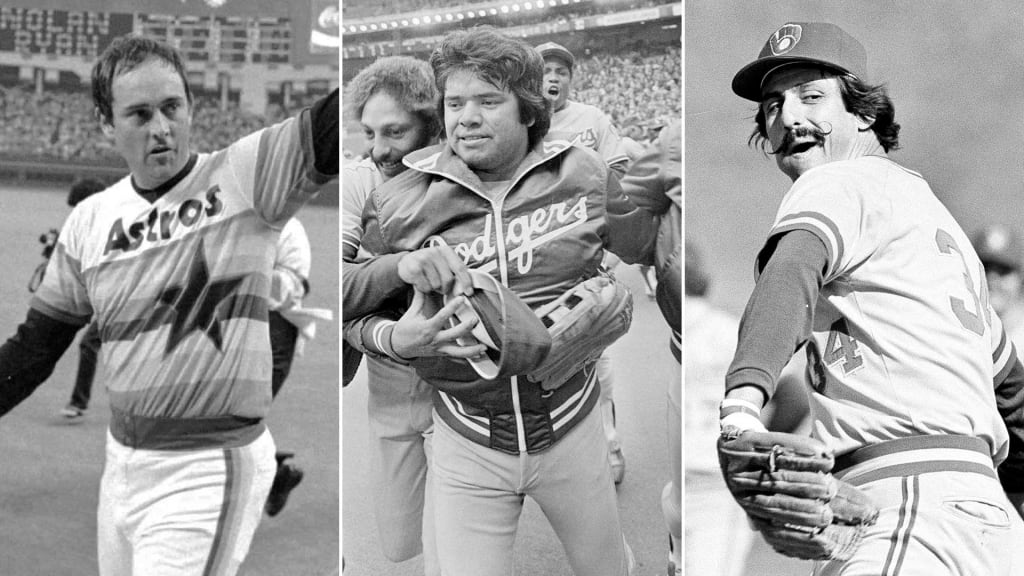
During this delay, we've been looking back at specific years in baseball history. Now that there is baseball -- there's going to be baseball! -- we end the series with a look at the season that may have the most similarities to this shortened season: 1981. Also: Welcome back, baseball. It is impossible to overstate how much we missed you.
Year: 1981
NLDS: Expos over Phillies in 5; Dodgers over Astros in 5
ALDS: A’s over Royals in 3; Yankees over Brewers in 5
LCS: Dodgers over Expos in 5; Yankees over A’s in 3
World Series: Dodgers over Yankees in 6
MVPs: AL: Rollie Fingers, Brewers; NL: Mike Schmidt, Phillies
Cy Youngs: AL: Rollie Fingers, Brewers; NL: Fernando Valenzuela, Dodgers
Rookies of the Year: AL: Dave Righetti, Yankees; NL: Fernando Valenzuela, Dodgers
All-MLB Team (chosen by me, in 2020):
1B: Eddie Murray, Orioles
2B: Bobby Grich, Angels
SS: Robin Yount, Brewers
3B: Mike Schmidt, Phillies
OF: Andre Dawson, Expos
OF: Rickey Henderson, A’s
OF: Dwight Evans, Red Sox
C: Gary Carter, Expos
DH: Greg Luzinski, White Sox
SP: Steve Carlton, Phillies
SP: Fernando Valenzuela, Dodgers
SP: Bert Blyleven, Indians
SP: Nolan Ryan, Astros
RP: Rollie Fingers, Brewers
RP: Bruce Sutter, Cardinals
If you were not a diehard baseball fan in 1981 -- if, say, you were a 5-year-old kid in Central Illinois, or even not born at all yet -- looking back at it now, it doesn’t seem that strange. The World Series certainly doesn’t look strange: It was the Dodgers vs. the Yankees, as iconic a World Series matchup as you could possibly find. (And one we somehow haven’t had since.)
There were all sorts of normal things that happened that year: A rookie breakthrough phenomenon (Fernandomania), future Hall of Famers having MVP-caliber seasons (Schmidt, Henderson, Dawson, Fingers), some no-hitters, trades, free-agent signings, all of it. If you weren’t there, it’s just another year. Until you look at the number of games everybody played and remember that the season was interrupted for 50 days by a player strike. Wait … the best team in baseball only won 66 games?
As we prepare for a baseball season that’s going to be 60 games, it’s worth keeping in mind that, eventually, once this 2020 season is folded over into history, those who didn’t live through it will not find it all that weird. The thing about record books is that they aren’t made of color and video motion; they’re just black-and-white figures and agate text. You really have to live through them to understand them. In the future, it will all just be backstory.
For example: They split the season in half to determine the playoffs -- with the standings before the season froze on June 12 locked into place, with the leaders of each division playing the winners of the second “half” of the season in a postseason playoff. Looking at it now without having lived through it in real time, it seems weird and unusual, perhaps. But to many people at the time, it must have felt unbelievable.
Perhaps inevitably, none of the teams that “won” the first half of the season -- the Phillies, Dodgers, Yankees and A’s -- “won” the second half, and all told, why would they? They already had a playoff slot sewn up. (To be fair, the A’s were close, just one game behind the Royals; amusingly, the Yankees fired the manager who won them the first playoff slot before he ever got a chance to play the actual series.)
Pity the poor Cardinals and Reds, who had the best overall records in their respective divisions that year but, because they didn’t time it correctly, they didn’t even make it to the Division Series. (The Cardinals must have been particularly frustrated: They finished a half-game out of the NL East lead in the second half, but only because the Expos played one more game than they did.)
But that’s just the way I look at it after investigating it more seriously, nearly 40 years later. If I wasn’t specifically narrowing in on 1981, I wouldn’t think of it that way, or even notice. I’d just see the World Series, and the MVP, and the Cy Young, and I wouldn’t see all that much all that different. It certainly looks a lot more normal than 1994. You go through the history books, and when you come across 1994, you stop. No World Series? What? But 1981, despite how odd it was, doesn’t feel like nearly as much of an aberration. It has the form and structure of the normal season. It’s just the husk that’s different.
And none of that really mattered come October. In October, the Yankees played the Dodgers, and Reggie Jackson and Dave Winfield and Dusty Baker and Steve Garvey were all there, and no one was thinking about labor issues, or the truncated season, or how counterintuitive the playoffs were. They were just watching baseball, with two of the sports’ most vaunted franchises playing for a championship that no one would ever discount, even if the season that produced it was unusual.
We do not know how the 2020 season is going to turn out; it certainly won’t be like any other any of us have experienced. But it’s got a chance, now, to be part of history. That might be all anyone could ask for.
Here are 10 other notable facts and moments from the 1981 baseball season.
1. We’ll start the breakdown with three notes about no-hitters. First: Nolan Ryan became the first-ever pitcher to throw five no-hitters on Sept. 26, passing Sandy Koufax with a win at the Astrodome over the Dodgers. He would end up throwing two more, including his seventh and final one a decade later, at the age of 44. To this day, no one else has even passed Koufax.
2. There has not been a perfect game thrown in baseball since 2012, when Félix Hernández threw his gem against the Tampa Bay Rays. That’s eight years, but when Len Barker threw his perfect game on May 15, 1981, against the Blue Jays, it had been 13 years since anyone had thrown one. (The previous one? Catfish Hunter’s in 1968.) Fun fact: Two of those 27 outs Barker got were made by Danny Ainge.
3. OK, last no-hitter note. In one of the most heralded college baseball games of all time, St. John’s beat Yale 1-0 in 12 innings. Both pitchers kept their starters in the game -- there was no official pitch count, but it estimated that each threw 170 pitches -- and the Yale pitcher had a no-hitter until the 12th, when a bloop single led to … three stolen bases and a walk-off victory. The Yale pitcher? Ron Darling. The St. John’s pitcher? Frank Viola. The game was so good that Roger Angell wrote a piece about it.
4. That still wasn’t the craziest game that year. The craziest game was an infamous 33-inning affair -- 33 innings! -- between the Pawtucket Red Sox and Rochester Red Wings. The game went 32 innings before being stopped after eight hours. It was resumed 67 days later, and only lasted 18 minutes before Pawtucket won. The game featured two future Hall of Famers: Cal Ripken Jr. (he went 2-for-13) and Wade Boggs (4-for-12). It is also the subject of an incredible book by New York Times reporter Dan Barry, "Bottom of the 33rd."
5. OK, this is too far to go without talking about Fernandomania. Fernando Valenzuela had thrown 17 2/3 scoreless innings in 1980, but from the moment he arrived in 1981 on Opening Day (taking over for Jerry Reuss, who was injured), he took over the sport. In his first eight starts: four earned runs allowed, seven complete games, five shutouts. He was an instant sensation.
Legendary Dodgers announcer Jaime Jarrín once said: “I truly believe that there is no other player in Major League history who created more new fans than Fernando Valenzuela. Sandy Koufax, Don Drysdale, Joe DiMaggio, even Babe Ruth did not. Fernando turned so many people from Mexico, Central America, South America into fans. He created interest in baseball among people who did not care about baseball.”
He’d end up being honored at the White House that year, winning the Rookie of the Year and the Cy Young, and taking home a World Series ring, one he helped win with a 147-pitch complete Game 3 victory. He would not turn 21 years old until the season was over.
6. The World Series had something highly unusual: Three MVPs. Apparently there was some pretty tight voting, because Pedro Guerrero, Steve Yeager and Ron Cey all shared the honor. Amusingly, the MVP trophy was presented to none of those people: It was presented to Steve Garvey, as a mistake.
7. Carlton Fisk had long battled with Boston ownership about his financial value, and it came to a head at the beginning of the 1981 season. Red Sox management sent Fisk his new contract one day after the deadline, turning him into a free agent earlier than he should have been. Fisk took advantage to sign a deal with the White Sox, where he would play the rest of his career. (He actually played more years in Chicago, 13, than he did in Boston, 11.)
8. Rollie Fingers was incredible in 1981, putting up a stunning 1.04 ERA at the age of 34 in his first season with the Brewers. It’s still surprising he would end up winning not just the Cy Young that season, but also the MVP. (Particularly because he only threw 78 innings, the fewest he had thrown in any season of his career.) He gave up just nine earned runs during the regular season, but he gave up two in the ALDS, which the Brewers lost to the Yankees in five games.
(All told, an MVP for Dwight Evans, who was arguably the best player in the AL that year, might have helped Evans’ Hall of Fame case.)
9. Mariners third baseman Lenny Randle produced one of my favorite sports highlights of all time in 1981:
(You should always be able to blow the ball foul if you can pull it off. OK, maybe not this year.)
10. We end with some more torture for Mets fans. The first overall pick of the 1981 Draft was Mike Moore, by the Mariners; second was Joe Carter by the Cubs. The 289th pick? A high school Texas named Roger Clemens, who chose to go to college at University of Texas instead of signing with New York. Clemens could have been a Met.
Other players drafted by teams they’d never play for that year? John Franco by the Dodgers, Mark McGwire by the Expos, Fred McGriff by the Yankees, Vince Coleman by the Phillies, Cecil Fielder by the Orioles and … John Elway by the Yankees.
